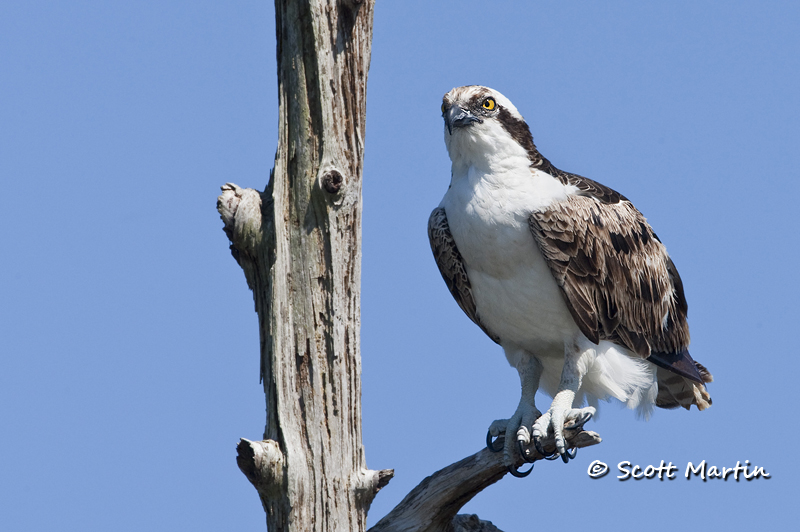
by Scott Martin Photography | Apr 12, 2011 | Birds, Blog, Raptors
The last blog entry concentrated on in-flight images of Osprey. It is very difficult to plan for in-flight shots although knowing the behaviour of the bird you are shooting does help in selecting the best vantage point to provide an increased likelihood of getting that perfect shot. Today’s post concentrates on a perched Osprey and a most fortunate situation where the bird remained on the perch for about ten minutes allowing time to set up for different shots and think about composition as well as positioning for the best light. All of the images today were shot using the EF 500mm f/4 L IS lens with a Canon 1.4x TC creating a focal length of 700mm. These shots were taken using a monopod as I didn’t want to risk setting up the tripod and have the bird leave his perch before I was set up…..an unfortunate occurrence that virtually every bird photographer has experienced at least one too many times!
These images are helped by a great perch that itself is visually interesting, a beautiful blue sky and a healthy Osprey who was perched only twelve feet above the surface of the water at the Viera Wetlands on the East coast of Florida.
This first image is a bit awkward compositionally as the free space required on the left (providing space for the bird to look into) positions the perch too centrally in the image for my liking and the angle to the sun leaves fairly large shadows across the neck and chest of the bird.

The next two images were taken from the same position however the ‘over the shoulder’ pose of the Osprey allows for free space to be placed on the right side of the image, moving the perch to a position that is much more appealing than in the first image. This results in the second & third images being much better photographs than the first. The third image was ‘warmed’ a little in post processing by increasing the white balance temperature about three hundred degrees. Adjusting the white balance in post processing can create subtle to rather dramatic changes in the final image, which is one of the many reasons to always shoot in RAW format where exposure and white balance can be adjusted in post processing. Neither of these two parameters can be changed if you shoot in JPEG format.
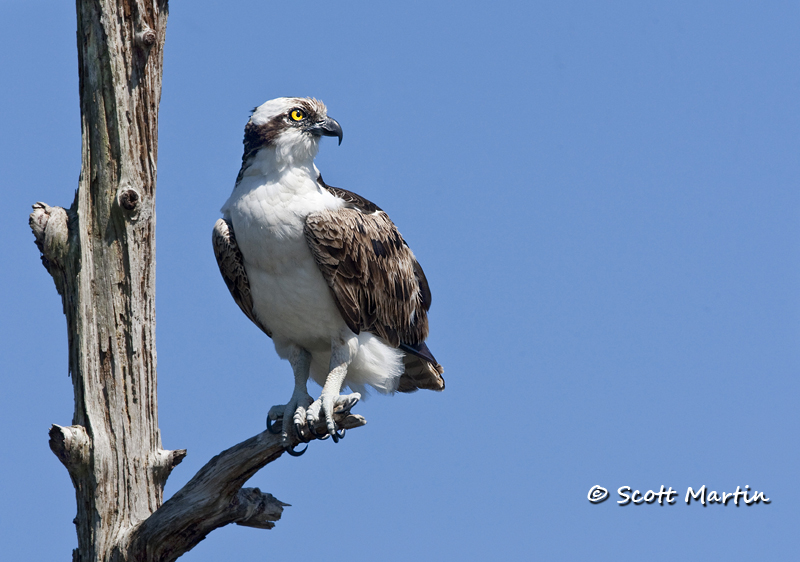
.
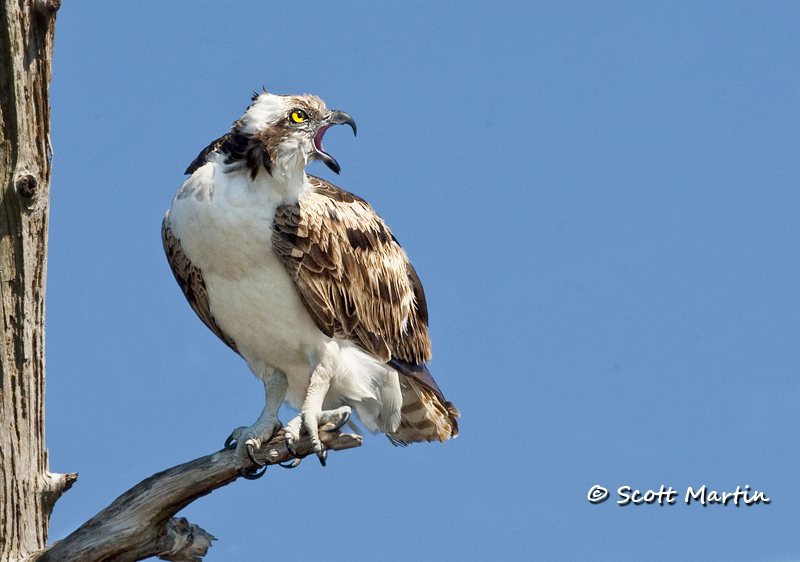
The position for the next image was changed in order to minimize the shadow across the neck of the bird, however doing this moved the perch directly behind the body of the bird, which should generally be avoided. Cropping the image vertically and keeping the perch out of the centre of the frame helps improve the composition. Shooting birds and landscapes in a portrait orientation is not often suggested, however often works well. When Bryan Peterson was asked when to shoot in a vertical format, his answer was “only after you’ve already taken the shot in a horizontal or landscape format”. This is good advice so after you’ve got all the shots you want in the landscape perspective, don’t forget to turn your camera ninety degrees and take a few more shots.
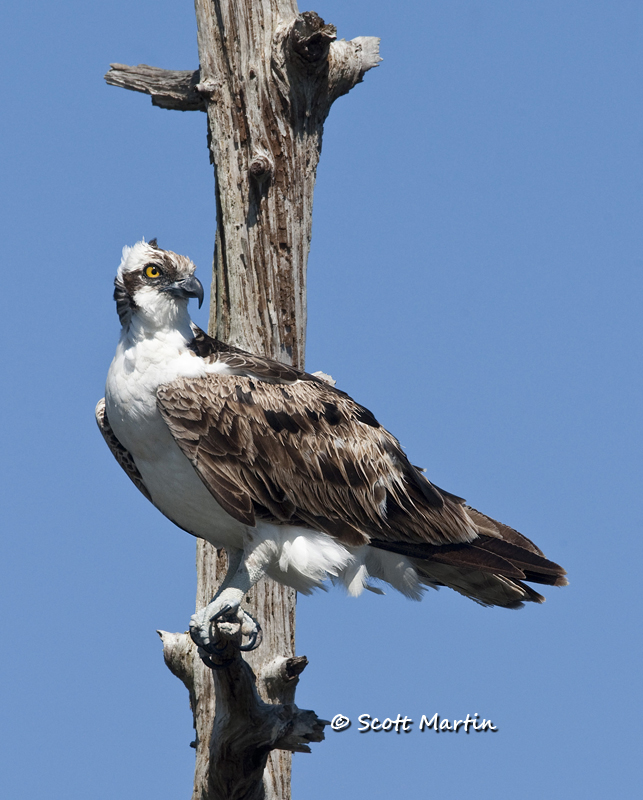
After posing wonderfully for about ten minutes it was time to head off and find another fish.
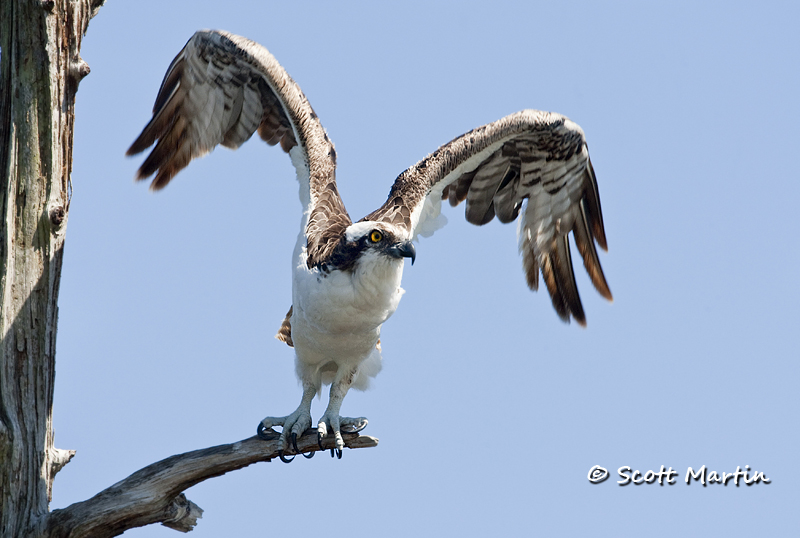
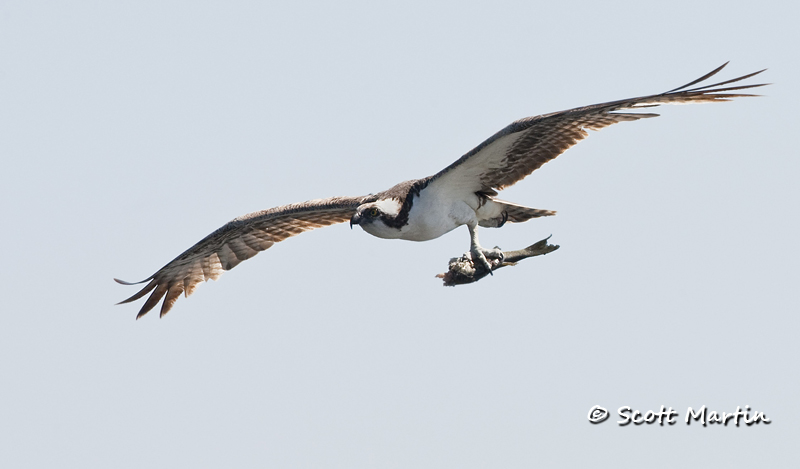
by Scott Martin Photography | Apr 10, 2011 | Birds, Blog, Raptors
Its been a whirlwind of activity around our place over the past month, so there has not been much time to process images and write blog posts, however it looks like things will be settling down a little and I can post some new images over the next few weeks.
Although Osprey used to be known as “Fish Hawks”, they should more accurately be known as “Salt or Sea Eagles” based on their scientific name, Pandion haliaetus (Greek ‘hal’ = salt or see; ‘aetos’ = eagle). The Osprey is the only raptor that feeds exclusively on live fish, which they catch by plunging into the water talons first, with such a force that they often completely submerge before coming up with a fish.
When Osprey fly while carrying a fish they always rotate the fish so it faces head first providing better aerodynamics as can be seen in these first two images.

.
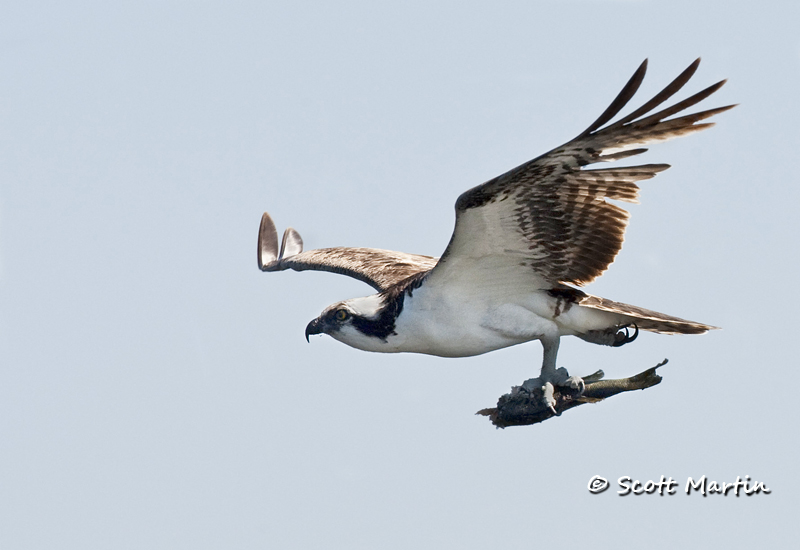
This is the same Osprey perched and ready for his meal, however I don’t think he liked having the camera pointed at him.
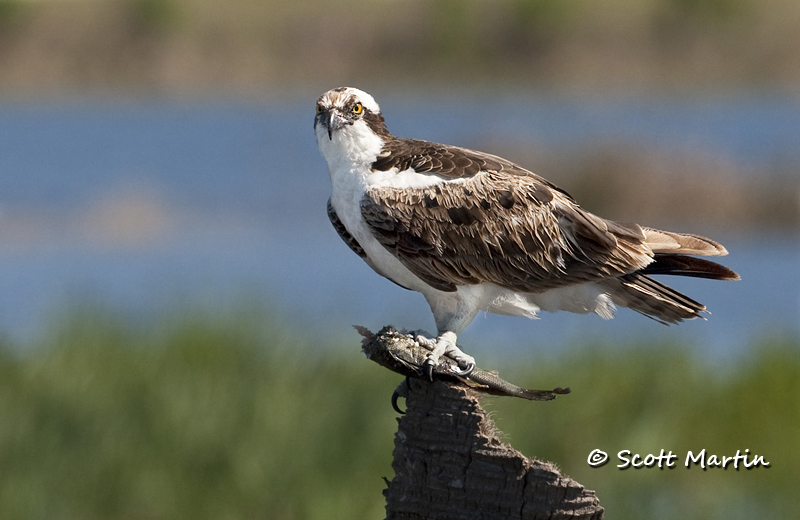
The previous three images were shot at the Viera Wetlands which are on the Atlantic Coast of Florida not too far south of Cape Canaveral and Cocoa Beach. The next image was taken at the Sebastian Inlet Nature & Wildlife Preserve which is located about an hour south of the Viera Wetlands. It’s not a great image however I like the way the strong back lighting illuminates the wings.
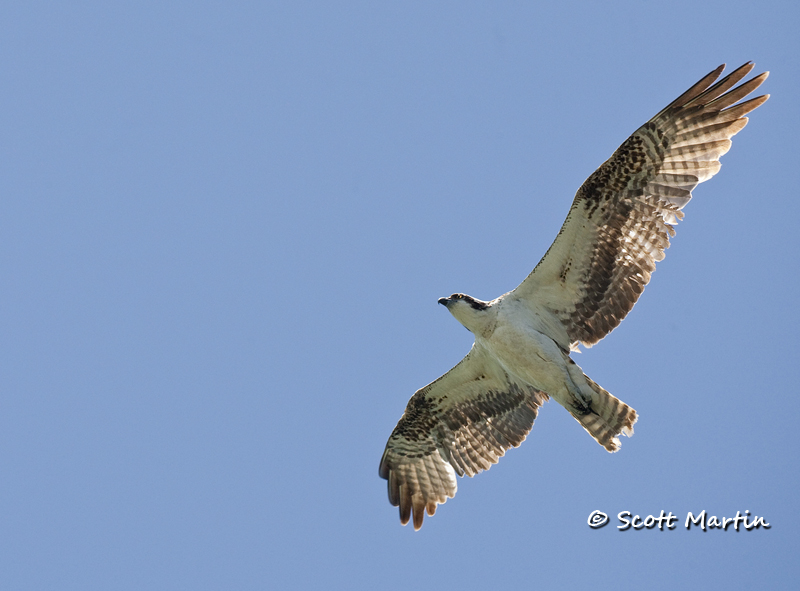
The next in flight image was taken from a boat we chartered in Lake Toho in order to photograph Snail Kites (which will be posted soon). Lake Toho is near Kissimmee in Central Florida.
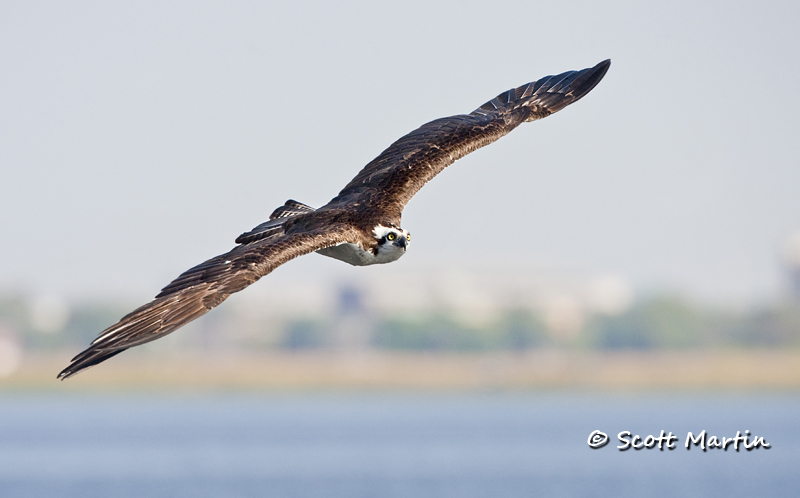
The last image for this blog post shows a female Osprey incubating her eggs which is a job shared by both parents. Osprey build large nests which they continue to construct over the years until they become quite huge. They are often built on platforms placed on telephone poles along highways in the south. In this case they were nesting on top of a wooden pole out in Lake Toho about ten feet above the lake surface.
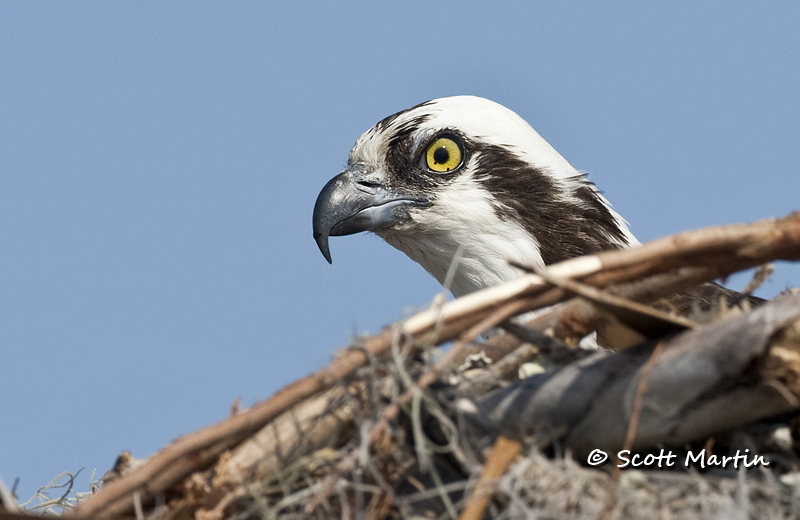
I’ll post part two of the Osprey photographs in the next couple of days.

by Scott Martin Photography | Mar 27, 2011 | Birds, Blog, Raptors
We’ve just returned from eleven fabulous days in Florida where we enjoyed perfect weather, great light and now have many gigs of CF cards filled and waiting to be processed.
While in Florida our son Jeff was engaged to Ellesse and they are getting married this October. Our daughter Lindsay and her fiancé Cam are getting married this summer so we are looking forward to a fun filled and busy few months ahead.
This post will be short as I haven’t had time to process many images yet and I’m experimenting with the WordPress iPhone app to make this post, which is a first for me. Stay tuned as there are lots of upcoming posts of Florida birds.
Here is an Osprey taken at the Viera Wetlands, on the Space Coast of Florida. It’s a Mecca for bird photographers and if you have never been there you need to put it on your list of places to visit.

43.919428-78.915892
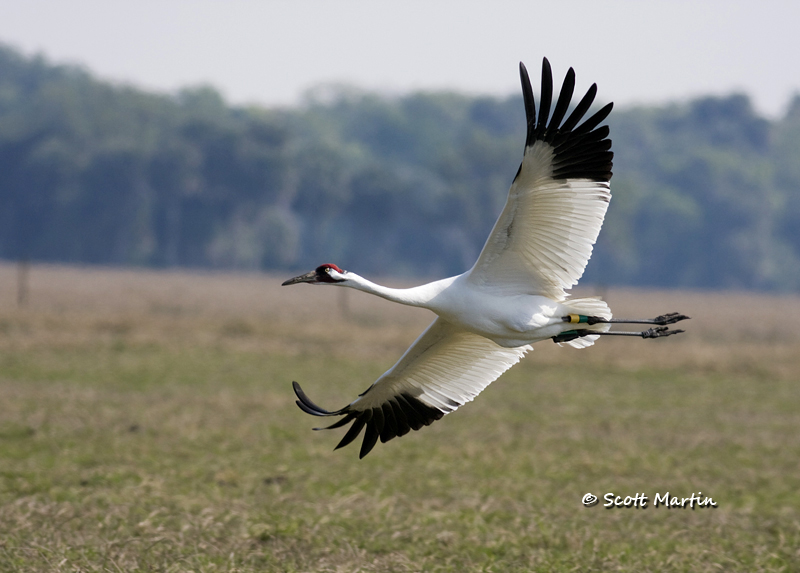
by Scott Martin Photography | Mar 3, 2011 | Birds, Blog, Raptors, Shore Birds & Waterfowl
For many years our family has joined the March Break Exodus and headed to Florida. It’s hard to believe that time of the year has arrived again! For a bird photographer March is a great time to be in Florida as many of the birds are nesting, which means they are also in their colourful breeding plumage.
Whenever you travel and are looking for birds, a great tip is to look through the yellow pages and find someone listed who makes custom bird houses and give them a call. My experience is that they will not only know where the birds are but also be willing to tell you! This is exactly what I did a few years ago and when the gentleman on the phone asked what types of birds I was looking for, my somewhat tongue-in-cheek reply was “Snail Kites and Whooping Cranes”. I was surprised when he answered “No problem, here’s exactly where you need to look”. Even more surprised were my wife and I when after driving about forty-five minutes to the location suggested we were greeted by four Whooping Cranes flying directly over top of our heads. It was an amazing sight which was followed by about an hour of watching two pairs of Whooping Cranes. After the Cranes moved on to another location we walked down to the shore line of Lake Kissimmee and within ten minutes a Snail Kite, clutching an Apple Snail flew by and offered the perfect photographic opportunity. We have gone back to the same location every year since and you guessed it, have not seen any Whooping Cranes or Snail Kites since!
Here is one of the Whooping Cranes from that day, taken hand-held with a Canon 40D and EF 400mm f/5.6 L lens.

Whooping Cranes are an endangered species and the rarest bird in North America with ~400 known wild birds. They are also North America’s tallest bird standing about six feet high with an eight foot wing span. The following image shows the relative size of the Whooping Crane….and no those are not miniature cows in the foreground 🙂
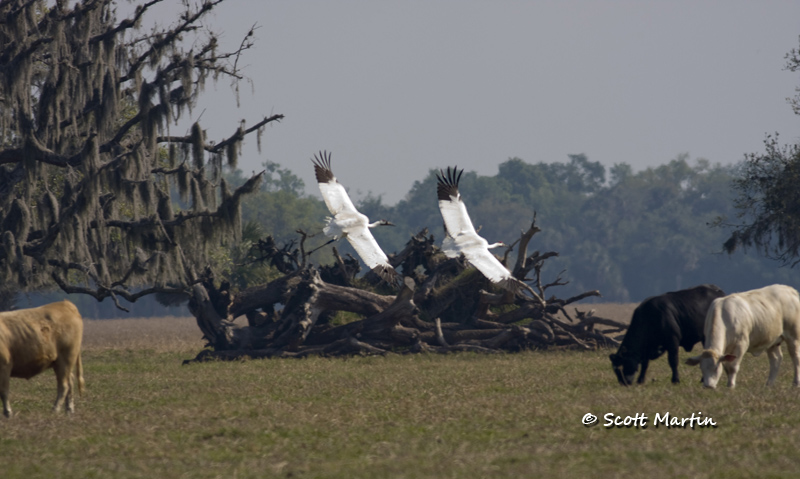
The Snail Kite is the rarest North American Raptor and is a locally endangered species in Florida where it is estimated there are about 400 breeding pairs. Their primary diet is the Apple Snail and they use their talons to deftly remove the snails from plant stems just below the water surface. They are so good at this process that they rarely get their feathers wet in the process.
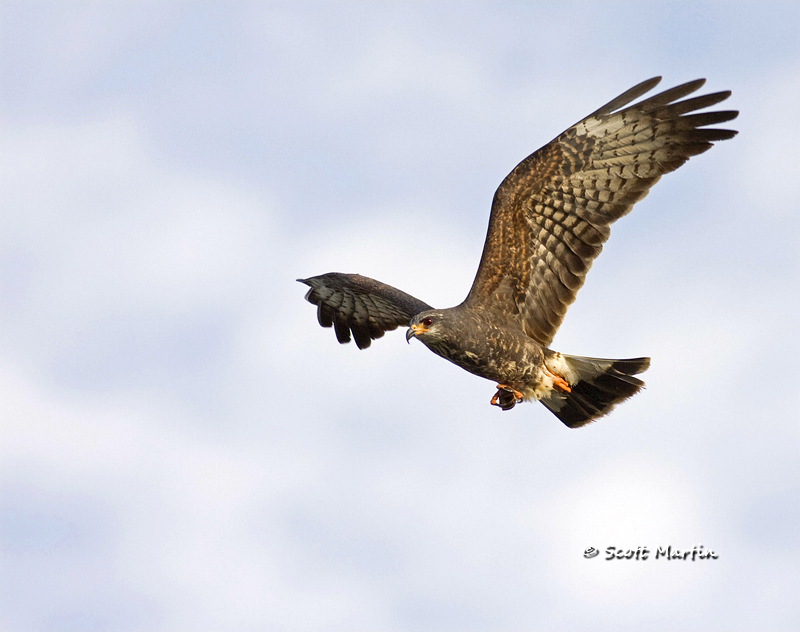
This year our goal is to photograph Snail Kites and Eagles while in Florida and who knows, perhaps even another Whooping Crane.
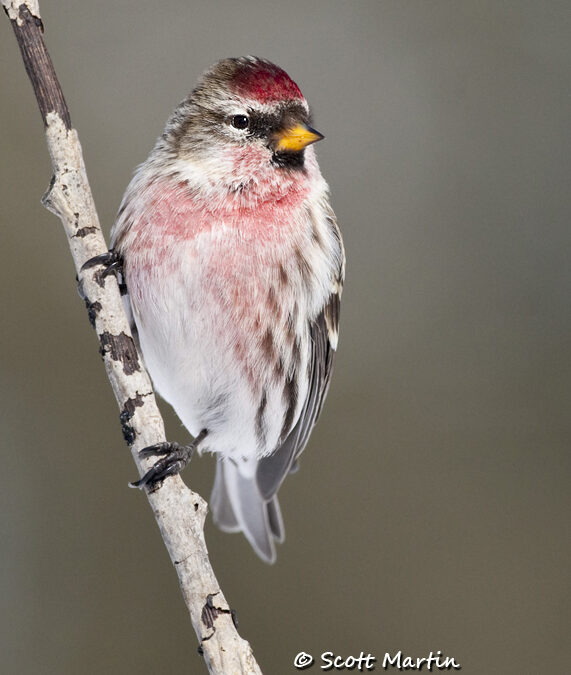
by Scott Martin Photography | Mar 1, 2011 | Birds, Blog
The winter irruption of Common Redpolls has been a welcomed surprise this year and these pretty little birds that often travel in nomadic flocks of a hundred or more have provided many great images for the photographer who has gone looking for them. They are also common in back yards that have maintained nyger seed feeders over the winter, so if you’ve been one of those fortunate people the Redpolls have come to you! Although I’ve already dedicated a blog post to the Redpolls, here are two more images that will most likely be the last until next winter.
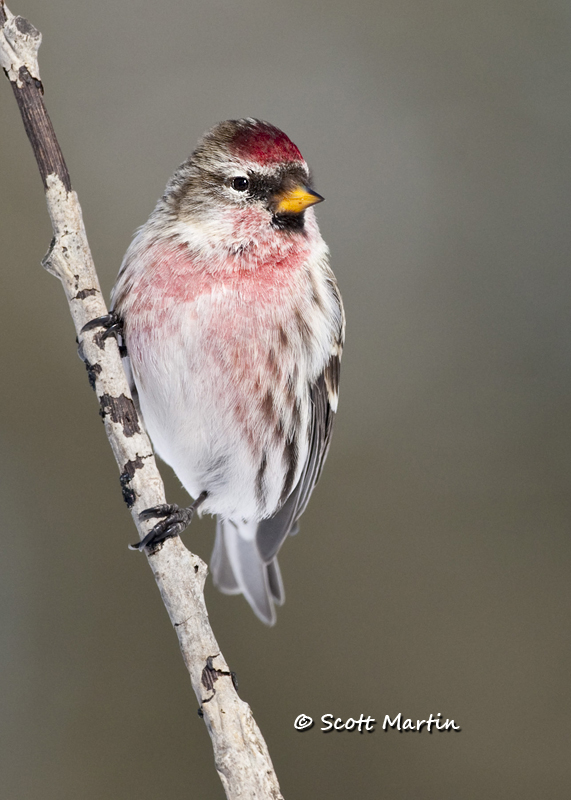
.
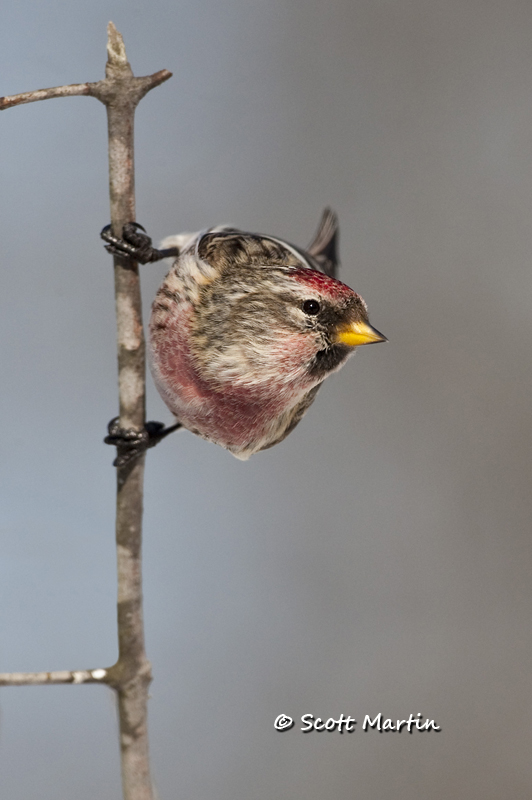
Both of the above images are of male Common Redpolls which differ from the females by their red coloured breast feathers.
The following images are from last summer however I’m just getting around to adding them to the website galleries. The first image is of a Brown Thrasher, which is a common bird that frequents thick bushes and spends much of its time on the ground (as in this image). They are a fairly skittish bird and don’t often provide great photo opportunities! The Brown Thrasher is a large bird measuring up to 30cm in length and lays its eggs in shallow nests on, or very close to the ground. This is a problem as they are prone to predation from snakes, skunks, weasels and other similar threats. The Brown Thrasher is a staunch defender of its nest and has been known to draw blood from anything, including unsuspecting birders and photographers who stray too close to an occupied nest. Perhaps what the Brown Thrasher is best known for is its wonderful and complex song. The Thrasher has the most extensive and varied vocal repertoire of any North American bird with an estimated 3,000 unique sounds they combine to form a multitude of songs and calls. In these parts of Ontario they are often heard and less frequently seen in the spring and summer months.
Click the link to hear the Brown Thrasher Call, from the Cornell Lab of Ornithology.
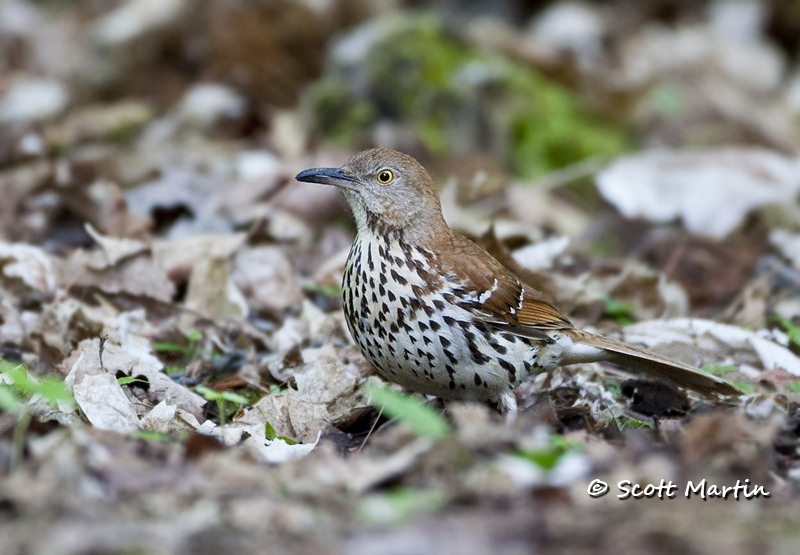
The last two images are of a Wood Thrush. Like the Brown Thrasher, Wood Thrushes prefer dense thickets and old world pine forests, such as Thickson’s Woods in Oshawa, where these images were shot. The Wood Thrush is smaller than the Thrasher, measuring about 20cm in length. Urbanization has caused the population of Wood Thrushes to be on the decline in Ontario and their reduced habitat has been largely taken over by a more common thrush, the American Robin. Like the Thrashers, Wood Thrushes have a beautiful song, which Henry David Thoreau described as the most beautiful of avian sounds.
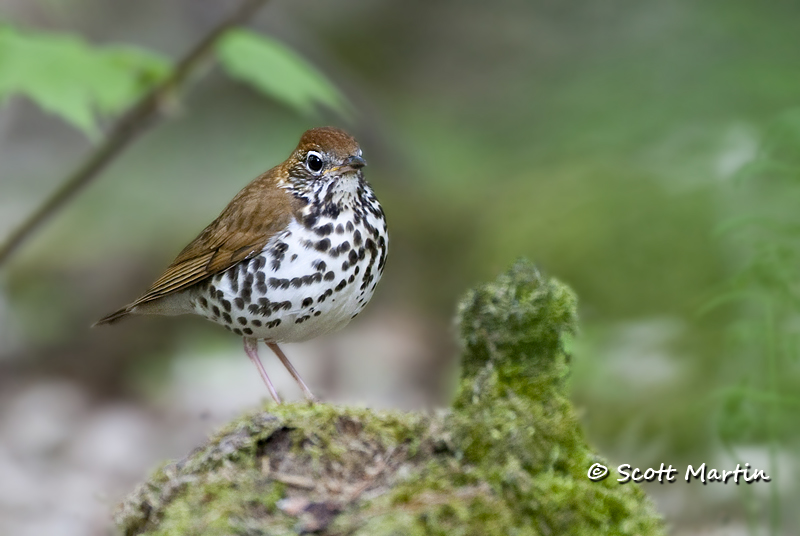
.
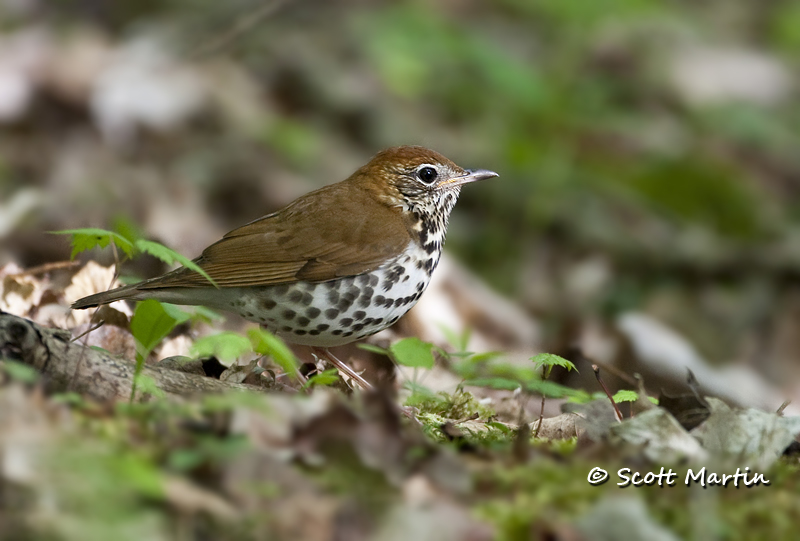
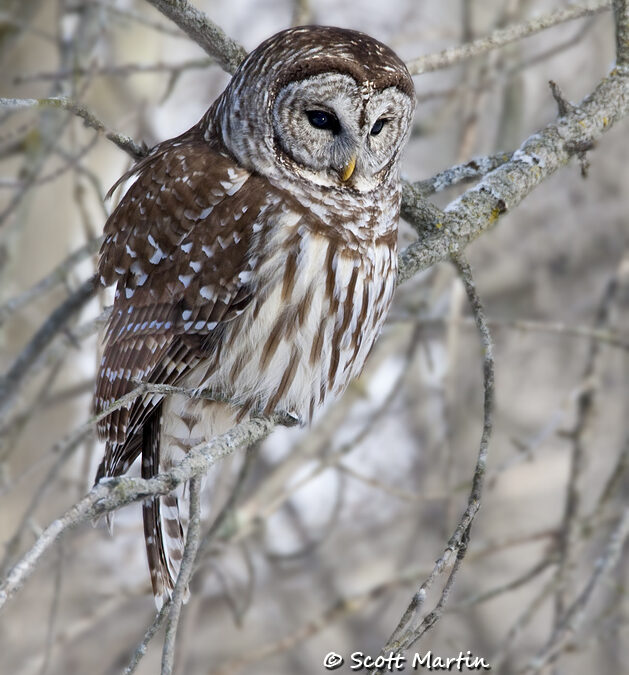
by Scott Martin Photography | Feb 18, 2011 | Birds, Blog, Raptors
Of the eleven different Owl species that are seen in Ontario, the Barred Owl is probably my favourite for any number of reasons; they are somewhat active during the day, they move around regularly providing opportunities to see them in flight, they can be very noisy and provide lots of interesting sounds, and they are photogenic.
Barred Owls have very dark eyes (unlike any other North American Owl save the Barn Owl) and are a large bird up to 62 cm in length and a wingspan of 1-1.3 metres making the larger than a Red Tailed Hawk with a wingspan greater than a crow. Barred Owls have fairly weak talons and therefore prey on smaller animals such as mice, voles and squirrels although they will also eat small amphibians and birds as well. Barred Owls nest in natural tree cavities where the female lays 2-3 eggs requiring about thirty days to incubate. The female remains on the eggs for all of the incubation period and the male brings her food.
Although the Barred Owl is one of the more popular Ontario Owls they are still uncommon and their numbers in Southern Ontario are on the decline as urbanization destroys the deciduous woodland environment they require to thrive.
We are fortunate to have a Barred Owl pair not too far from home and it was a pleasure for my friend Don & I to spend a while with one of them this past Saturday morning. At one point as the Owl relocated to another hunting area he flew just above eye level within about twenty feet of us which was amazing to see. They are virtually silent in flight and maneuver effortlessly through the dense forest cover for such a large bird.
The following images were taken at 700mm (500/4 + 1.4x TC) using a mono-pod for support.
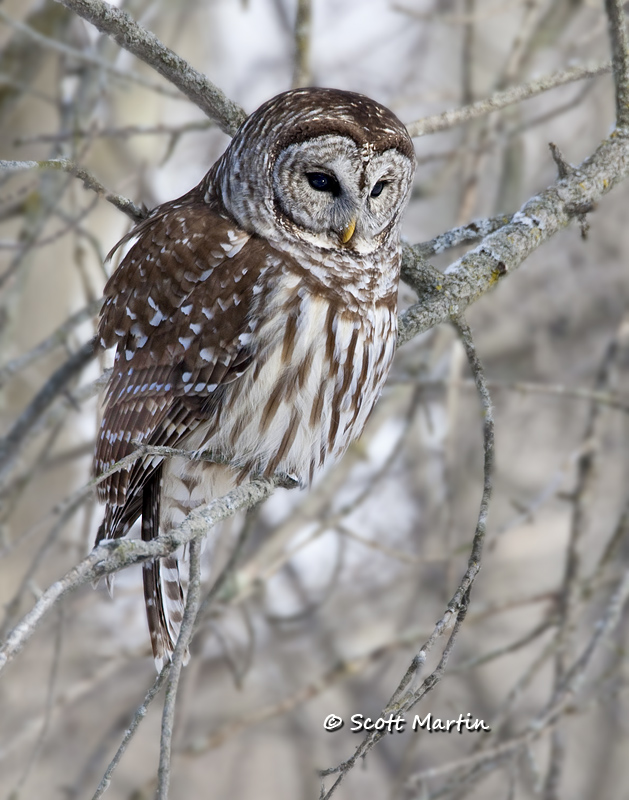
.
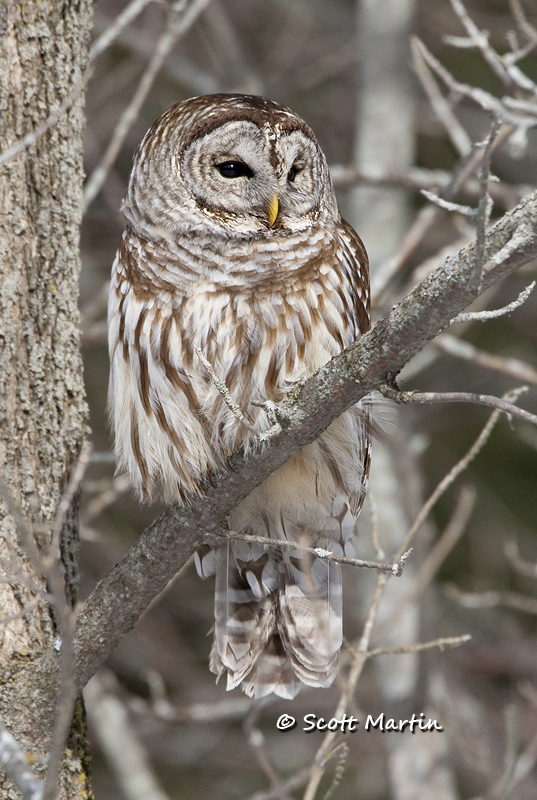
.
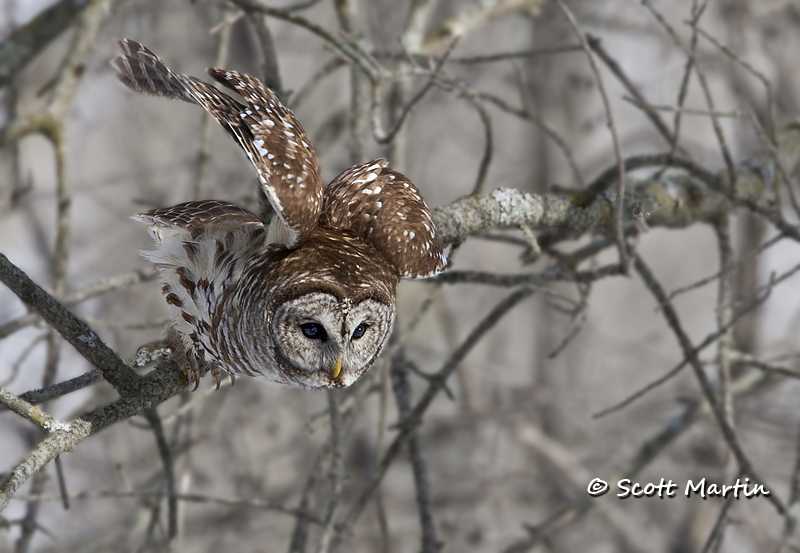
More Owls can be viewed by clicking the Owls Gallery. Please feel free to leave a comment as they are always appreciated, as are Tweets to your followers if you are so inclined….. just click the little icon below 🙂





























Follow Scott Martin Photography